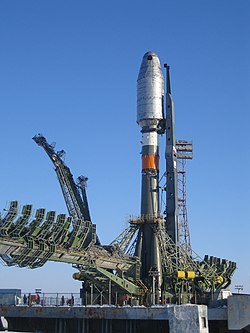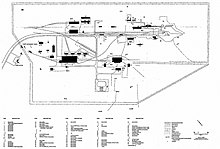
Back Startovací komplex č. 31 kosmodromu Bajkonur Czech Área 31 (Baikonur) Spanish बैकोनूर कॉस्मोड्रोम साइट 31 Hindi バイコヌール宇宙基地31番射点 Japanese Kompleks startowy nr 31 kosmodromu Bajkonur Polish Cosmódromo de Baikonur Plataforma 31 Portuguese Площадка 31 Russian Baykonur Uzay Üssü Site 31 Turkish Стартовий майданчик №31 космодрому Байконур Ukrainian 拜科努尔航天发射场31号发射区 Chinese
45°59′46″N 63°33′51″E / 45.99611°N 63.56417°E
 A Soyuz 2 rocket at LC-31/6 | |||||||||||||
 | |||||||||||||
| Launch site | Baikonur Cosmodrome | ||||||||||||
|---|---|---|---|---|---|---|---|---|---|---|---|---|---|
| Location | Kazakhstan | ||||||||||||
| Time zone | UTC+5 (AQTT) | ||||||||||||
| Operator | Strategic Missile Forces, Russian Aerospace Forces, Roscosmos | ||||||||||||
| Launch pad(s) | 1 | ||||||||||||
| Orbital inclination range | 49–99° | ||||||||||||
| |||||||||||||
Baikonur Site 31, also known as Site 31/6 at the Baikonur Cosmodrome, in Kazakhstan, is a launch site used by derivatives of the R-7 Semyorka missile. Since Roscosmos' change from flying crew on the Soyuz-FG to the Soyuz-2 launch vehicle for crewed flights in 2020, it has served as the primary launch site for Soyuz flights to the International Space Station. It took over from Site 1/5 (Gagarin's Start) after the latter failed to receive funding to modernize it for the slightly larger Soyuz-2 rocket.[1][verification needed]
Before that, it only saw a handful of crewed flights when Site 1/5 was unavailable (Soyuz TMA-06M, Soyuz TMA-15M, Soyuz MS-02).
It was first used on 14 January 1961, for an R-7A ICBM test mission. As of 2023 it is currently used for Soyuz-2 launches. In the 1970s and early 1980s, several crewed missions were launched from the site.

- ^ Berger, Eric (16 October 2023). "After six decades, 'Gagarin's Start' will meet its end as a launch pad". Ars Technica. Retrieved 24 October 2023.
